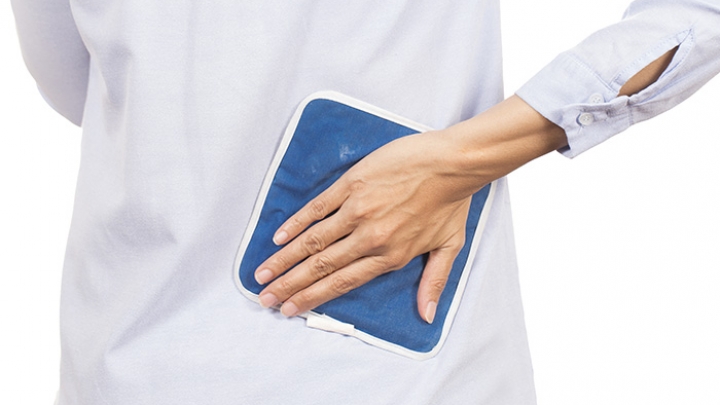(RxWiki News) Most episodes of back pain can be treated with a little self-care.
Most episodes of back pain—about 90%—clear up with little or no treatment in about six to eight weeks and often much sooner. This reduces the need for medical intervention.
If you have back pain that cannot be relieved in any position, and the pain persists unabated even when you are not moving, or it shows no improvement at all after a week, you should visit a physician.
Don’t try self-treatment if you have severe or unremitting back or leg pain or any of the following (might indicate a serious health concern):
- Severe nighttime pain or pain that worsens when lying down
- Weight loss
- Leg pain
- Numbness and tingling
- Weakness
- Bowel or bladder dysfunction
- Fever
- Cancer
- Infection
- Cauda equina syndrome
- Abdominal aortic aneurysm
As long as you don't have those signs, symptoms, or diagnoses, you can safely try self-treatment.
Self-treatment
If you don’t have any of the above symptoms or signs that you may have a serious health condition, you can take the following steps to help ease a backache:
Rest
Lying down takes pressure off the spine. It often can help lessen the pain. The best postures in bed are these two positions:
- Lying in the fetal position with a pillow between the knees
- On your back with knees flexed, using a pillow to support the legs
Most experts advise limiting bed rest to one or two days. Staying in bed for longer periods of time may do more harm than good by weakening muscles.
It’s better to get out of bed and move around as soon as you can do so with reasonable comfort, even if some pain persists. Until the pain fully disappears, you should avoid:
- Lifting
- Bending
- Vigorous exercise
- Other activities that place stress on the back
It may seem risky to move around when you still have back pain. But medical research supports limiting the amount of bed rest. One study found that people with acute back pain who went about their normal activities recovered more rapidly than those who were prescribed bed rest. Within a week, just 20% of the normal-activity group were still absent from work, compared with 41% of those on bed rest. After three months, people in the bed-rest group accumulated an average of about nine sick days, compared with five in the normal-activity group.
Activity should be increased gradually, as long as it doesn’t hurt and isn’t strenuous.
Ice
After a sudden back injury with pain limited to the back area, immediately applying ice can be therapeutic.
- Ice relieves pain
- Ice reduces internal bleeding
- Ice reduces swelling by decreasing blood flow
An ice bag, commercial cold pack, or even a package of frozen vegetables should be used for 10 to 20 minutes every two hours for the first 48 hours after injury (while you’re awake). The 20-minute limit is important to avoid the risk of frostbite. Another approach to relieving pain is to massage the painful area with an ice cube.
Heat
After an acute back injury, it’s best to wait 48 hours before applying heat. However, chronic back pain or a more widespread backache that begins sometime after a back injury may be eased by relaxing muscles. Types of heat applications that can help with back pain include:
- Hot bath
- Heating pad
- Heat lamp
- Hot, moist compresses
Over-the-counter medications
Over-the-counter medicines to reduce inflammation and pain fall into two categories:
- Analgesics
- Acetaminophen (Tylenol)
- Nonsteroidal anti-inflammatory drugs (NSAIDs)
- Aspirin
- Ibuprofen (Motrin, Advil)
- Naproxen (Aleve, Naprosyn)
- Ketoprofen (Orudis)
Be sure to read the labels and follow instructions carefully. Even over-the-counter medications can cause side effects if misused.
WARNING: Acetaminophen (Tylenol) can cause irreversible liver damage that can be fatal, if too much is taken at once or over a prolonged period. One should try to limit use of acetaminophen to a couple of days, and to stick carefully to dosages recommended on the packaging.
Exercise
Exercises for your back involve gentle stretching to relax back muscles and lengthen the spine to relieve compression of the vertebrae. These exercises are effective for relieving stress and strain on the back. Ask your doctor for a referral to a physical therapist or for printed instructions on how to safely perform the exercises. Doing back exercises in water also can be helpful.
A note about yoga: while yoga has been shown to improve neck, back, and knee pain, a small percentage of people said it caused new pain or exacerbated existing pain1. Do not push yourself to do poses beyond your ability or comfort level, and always let instructors know if you’re prone to any type of injury.
Traction, corsets, and braces
Little evidence supports the use of traction or corsets, although temporary use of a corset with built-in supports may be helpful during the recovery period following back surgery or during activities that have to be performed even when you are still experiencing pain. Whether back braces help in treating back pain is unclear.
Reference:
- Marc Campo. Journal of Bodywork and Movement Therapies, June, 2017.

